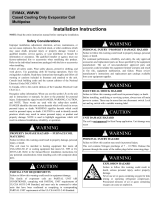
7. A WATER TRAP IS RECOMMENDED ON ALL
COIL APPLICATIONS, BUT IS REQUIRED ON
PULL THROUGH INSTALLATIONS ON
ELECTRIC FURNACES. FAILURE TO
PROVIDE CAN RESULT IN IMPROPER
DRAINAGE OR POTENTIAL SHOCK HAZARD.
8. Refrigerant piping is critical on any coil installation
when the outdoor unit is to be located below the
level of the coil. For proper piping design
considerations, refer to the guidelines furnished
by the manufacturer of the outdoor unit.
9. Check all field installed refrigerant connections
with electronic leak detector, halide torch, or soap
bubbles.
10. Refer to installation instructions provided with the
outdoor unit, gas or electric furnace, and line sets
for completion of system installation.
INSTALLATION WITH ELECTRIC FURNACE:
Typical electric furnace installation consists of a
coil without cabinet installed on top of a downflow
furnace or the coil inside a cavity on either a
downflow or upflow furnace.
The following NTKcoil installation kits are unique to
manufactured housing air conditioning and these kits
are required to complete the installation.
1. Filter-Electrostatic (95-1741-UES) is required
when using NTKcoil models on all electric
furnaces without cavities. [See #3 below}
2. A Coil Support Bracket (99-3420-14) is required
to support coils in Coleman furnaces.
3 Coil & Filter Cabinets (97-BCC-02N) are
recommended and many times required for
Nordyne furnaces as a preferred option.
Installation procedure:
1. Turn off electrical power to the furnace by
turning off breaker in house panel. CAUTION:
Furnace may be connected to more than one
supply circuit. Do not use furnace
disconnect only. Check power at furnace to
insure power is off.
2. Remove filter at top of furnace cabinet (Nortek
or Coleman only).
3. Remove refrigerant line knockout at top of
furnace (Nortek only).
4. Install insulation if needed.
5. Attach drain pan gasket provided with coil to
underside of coil pan and center evaporator coil
on furnace. See figure A on page 5.
6. Attach filters to sides of coil.
7. Route low voltage wiring, refrigerant lines and
drain tubing through floor penetration.
WARNING: If drain hose is below 40 Deg F
during installation warm before expanding
and/or forming.
8. Form 3” deep trap using (field supplied) tape
and (provided) flexible drain hose and connect
to coil pan drain securing with clamp provided.
See figure B on page 5. The most efficient use
of drain material is to form a “P” trap under the
house. All pull through furnaces must have a
condensate trap in the drain line.
9. Connect refrigerant lines per instructions with
line set. Make sure to lubricate quick connect
threads with refrigeration oil for proper mating.
Refer to outdoor unit installation instructions for
additional information on line set hook-ups and
proper torque values.
10. With the coil in place seal off any openings at top
or bottom of furnace to prevent air leakage or air
bypass (use silver backed tape provided, if
needed).
11. Turn power on to furnace.
12. Replace front door.
INSTALLATION WITH GAS FURNACE:
Typical downflow gas furnace installation consists
of a coil without cabinet installed in the cavity of a
downflow furnace. Coil with plastic pan is not
suitable for upflow oil furnaces.
Installation procedure:
1. Turn off electrical power to furnace.
2. Remove the lower front panel of the furnace,
and re-route any gas piping in front of coil
compartment as required to install coil.
3. Remove the coil cover panel(s).
4. Remove knockouts in front left bottom of
furnace for routing of refrigerant lines, low
voltage wiring, and condensate drain.
Page 3
It is mandatory to use an emergency auxiliary drain
pan with any coil or air handler installed in an attic or
above a finished ceiling. It must have its own drain
line (a water trap is not necessary) with its output into
an open drain (not a closed sewer). It should allow
easy visual inspection so that if condensate flow is
seen the homeowner knows that the coil drain pan
lines are plugged and need maintenance.
Do not install any coil containing refrigerant in a gas
furnace which is to be operated during the heating
season without attaching the refrigerant lines to the
coil. Possible coil damage will result from excessive
pressure build up during heating operation.
Contractor must comply with all local, state, and
federal codes and regulations when working with
gas piping. Personal injury or death may result from
improper installations!







